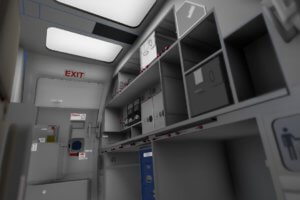Welcome to our recurring post, 3D Interactive Tech Talk, highlighting how interactive technology is being used right now and where it’s headed.
RAMPVR Offering Anytime, Anywhere Aircraft Tech Training
Available at IATA Training Centers worldwide, RAMPVR trains aircraft technicians in a variety of scenarios that would pose a challenge if attempted using traditional training methods. It removes the danger to technicians and allows practice on emergency situations or just abnormal scenarios, that would be difficult, if not impossible to recreate in real-time on an actual aircraft. Also, time of day, location, weather, equipment availability, restricted access areas and operator availability are all removed as training blocks. All that’s needed is a 3×3 meter indoor space.
Technicians can pay attention easier as the noise levels can be controlled and the training can be paused and reviewed as they go, ensuring an optimal experience with long-term retention.
PAL Using VR to Train Aircraft Cabin Crew
 Developed in coordination with the Civil Aviation Authority of the Philippines (CAAP), and adhering to its strict safety standards, Philippines Airlines has rolled out the country’s first and only VR training for cabin crew! The “training modules include aircraft familiarization and cabin door operations for Airbus A320 and A321 aircraft . . . simulating inflight situations that allow trainees to acquire and practice thought processes and skills under more realistic and vivid conditions, but in a safe, and virtual environment.”
Developed in coordination with the Civil Aviation Authority of the Philippines (CAAP), and adhering to its strict safety standards, Philippines Airlines has rolled out the country’s first and only VR training for cabin crew! The “training modules include aircraft familiarization and cabin door operations for Airbus A320 and A321 aircraft . . . simulating inflight situations that allow trainees to acquire and practice thought processes and skills under more realistic and vivid conditions, but in a safe, and virtual environment.”
The trainings are self-paced and the first of many the innovative airline plans to offer, as they recognize the value of immersive technology and its ability to offer safe, individualized training for pilots and crew.
Do you have a question regarding this technology? Hit us up here now to discuss how this could apply to your needs.
And check out our virtual training solutions to see 6 real world case studies on how businesses are training their operations, maintenance, and field service teams.


